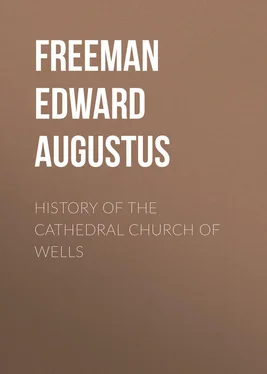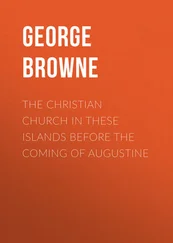Edward Freeman - History of the Cathedral Church of Wells
Здесь есть возможность читать онлайн «Edward Freeman - History of the Cathedral Church of Wells» — ознакомительный отрывок электронной книги совершенно бесплатно, а после прочтения отрывка купить полную версию. В некоторых случаях можно слушать аудио, скачать через торрент в формате fb2 и присутствует краткое содержание. Жанр: foreign_antique, foreign_prose, на английском языке. Описание произведения, (предисловие) а так же отзывы посетителей доступны на портале библиотеки ЛибКат.
- Название:History of the Cathedral Church of Wells
- Автор:
- Жанр:
- Год:неизвестен
- ISBN:нет данных
- Рейтинг книги:4 / 5. Голосов: 1
-
Избранное:Добавить в избранное
- Отзывы:
-
Ваша оценка:
- 80
- 1
- 2
- 3
- 4
- 5
History of the Cathedral Church of Wells: краткое содержание, описание и аннотация
Предлагаем к чтению аннотацию, описание, краткое содержание или предисловие (зависит от того, что написал сам автор книги «History of the Cathedral Church of Wells»). Если вы не нашли необходимую информацию о книге — напишите в комментариях, мы постараемся отыскать её.
History of the Cathedral Church of Wells — читать онлайн ознакомительный отрывок
Ниже представлен текст книги, разбитый по страницам. Система сохранения места последней прочитанной страницы, позволяет с удобством читать онлайн бесплатно книгу «History of the Cathedral Church of Wells», без необходимости каждый раз заново искать на чём Вы остановились. Поставьте закладку, и сможете в любой момент перейти на страницу, на которой закончили чтение.
Интервал:
Закладка:
The next Bishop was quite another kind of man. I know not whether he is reverenced at Bath, but we at Wells have certainly no reason to love his memory. You will remember that, as Gisa was Bishop from 1060 to 1088, the Norman Conquest of England came in his time. One result of that event was that all the Bishopricks and Abbeys of England were gradually filled by strangers, and much greater strangers to England than Duduc and Gisa had been. The new Bishops and Abbots, just as much as the new Earls, were almost all Normans or Frenchmen, who, I suspect, seldom learned to talk English. The first Bishop of Somersetshire after the Conquest was John de Villulâ, a Frenchman from Tours, who was appointed by William Rufus. About this time there was a great movement, which had begun under Edward the Confessor and which went on under William the Conqueror, for moving the sees or bishopstools of Bishops from smaller towns to greater ones. Thus, in our own part of England, Bishop Leofric, in King Edward's time, removed the united see of Devonshire and Cornwall from Crediton to Exeter, and in King William's time Bishop Hermann removed the united see of Dorsetshire and Wiltshire from Ramsbury and Sherborne to Salisbury. By Salisbury you will of course remember that I mean Old Sarum and not New. The historian William of Malmesbury, who wrote under Henry the First, calls this change the removal of Bishopricks from villages or small towns to cities. And among the villages or small towns from which Bishopricks were removed I am sorry to say that he reckons our city of Wells. 34 34 Will. Malms. Gest. Regg. iii. 300. "Pronunciatum est secundum dicta canonum ut episcopi transeuntes de villis constituerent sedes suas in urbibus diœcesium suarum." This was in 1072, but the change at Wells did not take place just yet. In his other book, the Gesta Pontificum (144 b ), he says that John "minoris gloriæ putans si in villâ resideret inglorius, transferre thronum in Bathoniam animo intendit."
For the first thing that the new Bishop John did was to remove his bishopstool from the church of Saint Andrew at Wells to the church of Saint Peter at Bath, on which William of Malmesbury remarks that Andrew, although the elder brother, was obliged to give way to his younger brother Simon. 35 35 William of Malmesbury, in the place last quoted, says, "Cessit enim Andreas Simoni fratri, frater major minori."
Bath was then, as now, a much larger town than Wells, and was a walled city, which Wells never has been. It was an old Roman town, which had been taken by the West-Saxons in 577, a good while before Somersetshire south of the Axe became English. 36 36 See the Chronicles under 577, and note 9.
The church of Saint Peter there was founded by Offa, King of the Mercians, for secular canons, but King Eadgar had, as in so many other churches, put monks instead, and Bath had ever since been a famous monastery. So, if the Bishop's see is necessarily to be fixed in the greatest town in the diocese, Bath was undoubtedly the right place, but it had the disadvantage of being much less central than Wells, being, as we all know, quite in a corner of the diocese. The Abbey of Bath was just then vacant by the death of the Abbot Ælfsige, an Englishman who had contrived to keep his office all through the reign of William the Conqueror; so Bishop John persuaded King William Rufus to grant the Abbey of Bath for the increase of the Bishoprick of Somersetshire. 37 37 The charters are given in Dugdale's Monasticon, ii. 66, 67. In the second charter of Henry the First he speaks of "Batha ubi frater meus Willielmus et ego constituimus et confirmavimus sedem episcopatûs totius Summersetæ, quæ olim erat apud villam quæ dicitur Wella." The grant of the town which is confirmed in this charter of Henry is made in a charter of William Rufus on the same page.
This was done by a charter in 1088, which was confirmed by two charters of Henry the First in 1100 and 1111. In the next year the Bishop begged or bought of the King the whole town of Bath, which had lately been burned. The effect of these changes was that the Abbey of Bath was merged in the Bishoprick. There was no longer a separate Abbot, but the Bishop was Abbot; the church of Saint Peter became his cathedral church, and its Prior and monks became his Chapter. The Bishop also, by his grant or purchase from the King, became temporal lord of the town. Bishop John, having thus got possession of Bath and all that was in it, spiritual and temporal, reigned there at first somewhat sternly. He was, as I have said, a foreigner; he was also a skilful physician and fond of learned men of every kind. The monks of Bath, no doubt mostly Englishmen, he despised as ignorant barbarians; so he oppressed them and cut their living very short, till afterwards, we are told, he repented, and gave them their possessions back again. 38 38 So says William of Malmesbury in the passage last quoted: "Aliquantum dure in monachos agebat, quod essent hebetes et ejus æstimatione barbari."
He also rebuilt the church of Bath, now become his cathedral church, and greatly enriched it with ornaments and the like, and then, after being Bishop for thirty-six years, he died and was buried in 1124.
But it more concerns us to know what was going on at Wells all this time. The see had been altogether taken away, so much so that one of the charters of Henry the First speaks of the see of all Somersetshire having been moved to Bath from the town which is called Wells. I conceive that the Bishop of Bath now looked on Wells simply as one of the lordships of the see, just like Banwell, Evercreech, Wookey, or any other, where the Bishops had houses and where they occasionally lived. So, among his other doings, Bishop John built himself a house at Wells. But the way in which he found himself a site and materials was a somewhat remarkable one. For it was by pulling down all the buildings that Gisa had built for the use of the Canons, and building his own house on the spot. 39 39 The Historiola mentions the destruction of Gisa's buildings, and the Canon of Wells adds (Anglia Sacra, i. 560), "Fundum in quo prius habitabant sibi et suis successoribus usurpavit, palatiumque suum episcopale ibidem construxit."
Now this shows that either the church or the Bishop's Palace has changed its place since the time of John of Tours. For we may be sure that Gisa built his cloister, refectory, and dormitory close to the church, just as they would be in a monastery. Therefore, if John built his house on their site, it must have been much nearer to the church than the present palace is. Nothing is left of either the church or the palace as they stood then, and it is most likely that the site of the palace has been changed, and that Gisa's canonical buildings and John's manor-house both stood where the cloister, library, &c. stand now. But I thought it worth while to mention this, because it was not very uncommon, when a church was rebuilt, to build the new church a little way off from the old one. 40 40 See Willis' Architectural History of Winchester, 34, 35.
The reason for this was, that the service might go on in the old church while the new one was building; and when the new church was finished, the old one was pulled down and the new used instead. It is therefore quite possible that our present cathedral does not stand quite on the same site as the church which was standing in Gisa and John's time. But on the whole the chances are the other way.
The Canons of Wells were thus turned out of the buildings which Gisa had made for them, and were driven to live where they could in the town. 41 41 Historiola, p. 22. "Canonici foras ejecti coacti sunt cum populo communiter vivere."
The great and learned Bishop of Bath cared nothing about them, or rather he made spoil of them in every way. A portion of their estates, valued then at thirty pounds a year, was held by the Bishop's steward, Hildebert by name, who seems also to have been his brother and to have held the office of Provost of the Canons. On Hildebert's death, the estate, by the Bishop's assent, passed as an hereditary possession to his son John, who is described as Archdeacon and Provost. 42 42 The story of Hildebert, John, and the Provostship is given both in the Historiola and by the Canon of Wells. Several letters discussing the matter appeared in the Gentleman's Magazine in the year 1864 in the numbers for February, July, August, September, October, November, and December, especially one by Mr. Stubbs in November. That Hildebert was the brother of Bishop John appears from a charter of Bishop Robert (which I shall have to quote again) in the Monasticon, ii. 293, where Bishop John is called the uncle of Precentor Reginald.
As I understand the matter, the estate became a kind of impropriation; Hildebert, John, and their heirs held the estate, and paid the Canons a fixed rent-charge. For though we read of the estate being taken away from the Church, yet we also read incidentally that Provost John paid each Canon sixty shillings yearly. 43 43 This comes afterwards in the Historiola, p. 24.
This would seem to show that there were ten Canons, among whom the thirty pounds had to be divided. But as we read that, when Bishop Robert recovered the property, he paid each Canon a hundred shillings, it would seem that the estate increased in value, but that John simply paid the Canons their old stipends, taking to himself the surplus, which should no doubt have been employed either in raising the stipends of the existing Canons or else in increasing their number. This is the kind of abuse which we constantly light upon in all manner of institutions, and we see that at all events it is not a new abuse. Canons in their own infancy were treated by Provosts much as Canons, in the days of their greater developement, have in different places treated Minor Canons, Singing Men, Grammar-Boys, and Poor Knights. The peculiar thing is that the Provostship became hereditary, subject only to this fixed charge, exactly like a lay rectory charged with a payment to the Vicar.
Интервал:
Закладка:
Похожие книги на «History of the Cathedral Church of Wells»
Представляем Вашему вниманию похожие книги на «History of the Cathedral Church of Wells» списком для выбора. Мы отобрали схожую по названию и смыслу литературу в надежде предоставить читателям больше вариантов отыскать новые, интересные, ещё непрочитанные произведения.
Обсуждение, отзывы о книге «History of the Cathedral Church of Wells» и просто собственные мнения читателей. Оставьте ваши комментарии, напишите, что Вы думаете о произведении, его смысле или главных героях. Укажите что конкретно понравилось, а что нет, и почему Вы так считаете.












